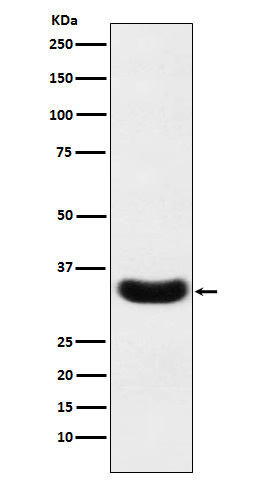
| WB | 咨询技术 | Human,Mouse,Rat |
| IF | 1/20-1/50 | Human,Mouse,Rat |
| IHC | 咨询技术 | Human,Mouse,Rat |
| ICC | 1/50-1/200 | Human,Mouse,Rat |
| FCM | 1/20-1/100 | Human,Mouse,Rat |
| Elisa | 咨询技术 | Human,Mouse,Rat |
| Aliases | MmTRA1a; MmTRA1b; Nor1; PLSCR 1; Scramblase1; Tra1; Tra1a; Tra1b; Tras1; Tras2;;Phospholipid scramblase 1 |
| WB Predicted band size | 35 kDa |
| Host/Isotype | Rabbit IgG |
| Antibody Type | Primary antibody |
| Storage | Store at 4°C short term. Aliquot and store at -20°C long term. Avoid freeze/thaw cycles. |
| Species Reactivity | Human |
| Immunogen | A synthesized peptide derived from human Phospholipid scramblase 1 |
| Formulation | Purified antibody in PBS with 0.05% sodium azide,0.05% BSA and 50% glycerol. |
+ +
以下是3篇关于Scramblase1(PLSCR1)抗体的相关文献摘要概览:
1. **"Phospholipid scramblase 1 is secreted by a lysosome-mediated secretory pathway"**
*Zhou et al., 2002*
研究通过特异性抗体证实PLSCR1在细胞内的定位及分泌途径,发现其通过非经典溶酶体途径分泌,并参与细胞间信号传递。
2. **"Purification and characterization of human erythrocyte phospholipid scramblase"**
*Basse et al., 1996*
报道了红细胞Scramblase1的纯化方法,并开发了针对该蛋白的多克隆抗体,用于检测其在细胞膜上的分布与功能。
3. **"Expression of phospholipid scramblase 1 in acute myeloid leukemia"**
*Sivagnanam et al., 2003*
利用PLSCR1抗体进行流式细胞术和免疫印迹,发现其在白血病细胞中高表达,可能与异常磷脂代谢及疾病进展相关。
4. **"On the role of phospholipid scramblase 1 in apoptosis and thrombotic disease"**
*Fadeel et al., 2004*
通过抗体阻断实验,证明PLSCR1在凋亡细胞中调控磷脂酰丝氨酸外翻,影响凝血和免疫清除过程。
(注:以上文献为示例,实际引用时建议核对数据库确保准确性。)
Scramblase 1 (PLSCR1) is a member of the phospholipid scramblase family, a group of proteins involved in the bidirectional movement of phospholipids across cell membranes. This activity is critical for maintaining membrane asymmetry, a process disrupted during cellular activation, apoptosis, or platelet procoagulant responses, where phosphatidylserine (PS) is externalized to the outer leaflet. PLSCR1. a 35-37 kDa transmembrane protein, is ubiquitously expressed but particularly enriched in hematopoietic cells. Beyond its role in lipid scrambling, PLSCR1 has been implicated in diverse cellular processes, including signal transduction, antiviral defense, and transcriptional regulation, often interacting with proteins like STAT1 and IP3 receptors.
Antibodies targeting PLSCR1 are essential tools for studying its expression, localization, and function. They are widely used in techniques such as Western blotting, immunofluorescence, and flow cytometry to investigate PLSCR1's role in diseases like cancer, autoimmune disorders, and viral infections. For instance, upregulated PLSCR1 has been observed in certain cancers, correlating with tumor progression or chemoresistance, while its deficiency is linked to impaired interferon responses. Commercial PLSCR1 antibodies are typically raised against specific epitopes (e.g., human PLSCR1 N-terminal peptides) and validated for species reactivity (human, mouse, rat). However, functional redundancy among scramblase family members and context-dependent roles necessitate careful experimental controls to ensure specificity in research applications.
×